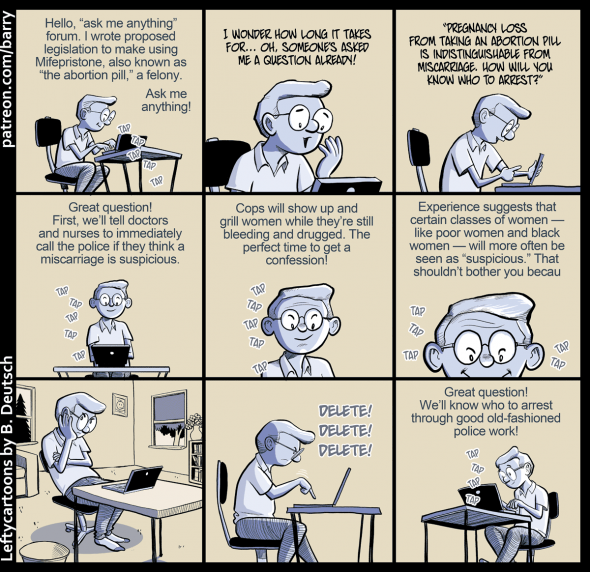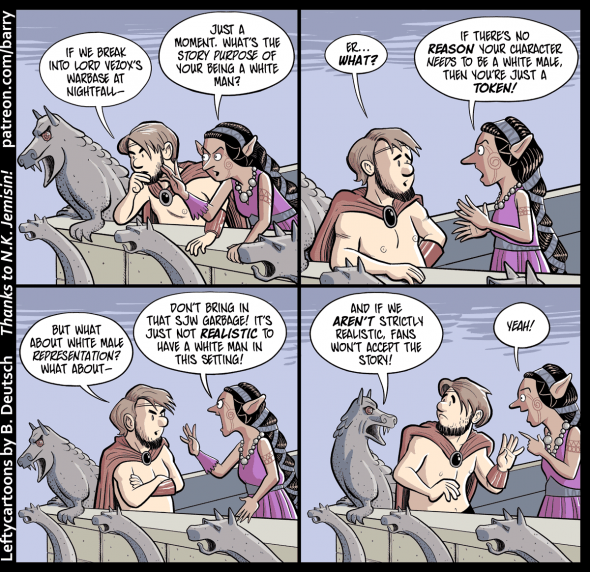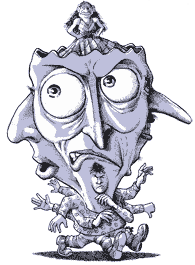Here’s me! The outfit is Miranda Harrell’s version of the clothing style for the villains (?) of my RPG, Nobilis: A Game of Sovereign Powers.
Here’s my website! https://afarandasunlessland.wordpress.com/
Rachel Swirsky: You have a PhD in computer science. What made you fall in love with the subject?
Jenna Katerin Moran: We’re one of those rare Tinder success stories! You would not believe how many clunkers I had to date through to get there, though.
(Example: trossulography. Trossulography tried to have like five PhD students just in one city alone without telling any of us about one another … and it probably would have worked fine, too, except we all had to submit to the same journals.)
RS: How does your academic training in computer science affect how you write role playing games?
JKM: There are some really good discussions out there of marketing techniques, cultural trends, and American gamer purchasing habits if you know which Russian servers to hack.
RS: I’m sure you get this question all the time, but I feel like it’s pretty relevant for an audience of people who aren’t all tabletop gamers. How and why did you end up falling into writing table top RPGs?
JKM: So it was like the year 1997? Ish? I don’t know. A little before Y2K, when I would have had to get out of the field of computer science (for, like, obvious reasons) anyway. And I was looking for something good to write because, y’know, it’s not like one can stop the writing, right? I mean, one tries, right, one goes and, like, tries to pursue other careers, or, curls up in one’s closet and wails in despair, or, moves to China and tries to become a foreign pop idol—like, Jenna Starlight Sparkles; whatever—but then one has barely turned around again before discovering that one has just been writing. I mean, y’know? (It is only when one has sighed and given in and accepted that one must be a writer that there is a possibility, er, uh, probability, … near-certainty? Uh, that the words will stop.) But, anyway, so, I was looking for something good to write, and naturally I settled on pornography; only, being a … regrettably … uh, prudish? person, I had to use fairly roundabout and esoteric euphemisms for everything. Long story short, it accidentally came out as an urban fantasy roleplaying game about people with conceptual powers in a world under existential threat from the inhabitants of the beyond. (If you know what I mean, and I think you do.) Only, in fact, despite that parenthetical that I have just shared with you, hardly anybody knew what I meant, or, at least, I think they didn’t? and once it got popular, I was way, way too embarrassed to ever tell anyone. I had thought that, like, 2000-era fanfic would have sensitized people to it? You know, to, uh, roundabout euphemisms? Like, what with, you know, all that, “his melancholy duck quacked down into the shimmering epilimnion of her pond” kind of thing that was, like, the style of the time? but apparently “each player designs a player character (PC for short), one of the protagonists in the story” was just one bridge too far. So now, suddenly, instead of taking my pornography into the bedroom, people were, y’know, propping it up on the coffee table and showing it to their parents and inviting groups of friends and strangers to their houses to talk about it together and I thought suddenly, wait. What if I just did this as a business and wrote for RPGs instead?
RS: Your cat, Kennedy, prefers that you pay attention to her at all times. What do you think is her current inner monologue as you do this interview? (Illustrating with photographs is highly encouraged!)

JKM: I suspect she is wondering if she is sleeping correctly. She is wondering if, perhaps, there is some proper way of sleeping that she was meant to be practicing, but which no one has ever explicitly explained to her, only making allusions to it, talking about “catnaps,” and sleeping awkwardly in her vicinity instead, and leaving her with no recourse but to guess.
Perhaps that is why (she thinks) she is sometimes left alone, to wither and wail in her hopeless misery, while her emotional comfort hominid cavorts beyond the gates with the other cat. Perhaps her failing at proper sleeping is the reason, there—
But if that is why, it is so unfair!

It is not her fault that nobody has taught her how to sleep correctly. It is not her fault that nobody has explained how to get past the top shelf of the bookshelf to the notional higher height that she knows must, logically, exist— for it would not make sense for a mathematical series to carry itself to the top of the bookshelf and then stop— or what the exact rules as to when she may use the two litterboxes that are reserved entirely for her use, that she has access to 24/7, are. It is not her fault that the correct propitiation to the household gods to allow her to go upstairs sans incident has not been made; if the upstairs cat would just tell her what the format of that ritual is supposed to be …
But, enough dwelling on the other cat. Let us return to the puzzle of the litterboxes; as noxious a thing as they may be, still, to her they are more sweet.
It is obvious, she believes, that there must be rules as to their use, because they cannot be used by a single cat, alone. A single cat, alone, entering the litterbox, enters a kind of quantum state— nobody has ever given her a proper explanation of quantum physics, so physicists must forgive her if she gets this wrong— enters a kind of “quantum state” where one may exist, in the outside world, or one may not. Arguably, when one enters into the box, as a fully defined and differentiated entity, one ceases therewith to be. The only anodyne to this noisome quandary is witness: to be witnessed, to have independent affirmation of one’s existence, to have an external force creating continuity from one’s entrance into the box … to one’s exit. But much of the time, this warrant cannot be obtained; no witness can be pressed into service; and the litterboxes, therefore, must lie fallow: the proper rules for this are, as yet, unknown.
Outside the window, in the vaster, greater world, where monsters roam— she knows this; one presses its face against the window, sometimes, at night— there may be entities that know the rules to all such things. Outside the window, one day, if the hominids would only leave the window open at all times as she has asked them to, she may smell and hear as one such beast walks past:
A nebulous, smoke-stack figure in the distance, made of words and bleeding doctrine.
When she sees it, smells it, hears it; when the wind carries to her the shadows of its words— again, if the window has been properly left open—
Then she may, finally, begin to know.

RS: What projects are you currently working on?
JKM: My major project right now is Glitch: A Story of the Not, which is an RPG about surprisingly relatable evil gods who don’t actually know what they’re doing with their lives but are pretty sure that it shouldn’t actually be bringing an end to everything like they had previously thought. I guess the central thesis of the game is something like, “So, there’s an intrinsic universal characteristic of suffering— what do you do?” Only, unlike some RPGs, you can’t then roll for initiative against the intrinsic universal characteristic of suffering, because Glitch uses a cost-based system instead of dice.
Queued up behind that is A Book of Golden Hours, which represents a quixotic effort to break character arcs down into eight basic stories, split that again based on whether the character is getting cooperation, active interference, or neither from the world, and turn the result into twenty-four character classes with powers abstract and high-level enough that each can actually handle the roughly 4% of fictional characters that they wind up representing. It’s not just an RPG supplement, it’s also a unique work of orphic cubist literary criticism!
Then there’s Adventures on the Far Roofs, which is about fighting god-monsters with heroic talking rats at your side up on the rooftops out where the roofs start to blend together until you can’t be sure there are actually any houses underneath. That one’s been written for a long time, but it uses content from A Book of Golden Hours so it can’t come first.
For my patreon consumers I’ve been building a campaign—a set of pre-made characters and stories—for my game, the Chuubo’s Marvelous Wish-Granting Engine RPG. I’ve also lately been sharing a mildly updated version of an old cyberpunk setting of mine. Those’ll both be wanting to go into print sometime after they’re done.
Finally, I have a novel—the Night-Bird’s Feather—that’s gone temporarily back into editing at the moment after some new reader feedback. It’s a book of stories about cross-time dream magic and the mental origins of valuation. I’m really excited about it!
Oh, and tonight I was thinking of making soup?
OK, that’s all.
 Bunny Chicken is a character I drew for a role-playing game I was sketching out called Cats and Dogs Living Together.
Bunny Chicken is a character I drew for a role-playing game I was sketching out called Cats and Dogs Living Together.
 My online speculative poetry class,
My online speculative poetry class, 





 Zippy is a character I drew for a role-playing game I was sketching out called Cats and Dogs Living Together.
Zippy is a character I drew for a role-playing game I was sketching out called Cats and Dogs Living Together.

Also, to alleviate any concerns that ICE won't arrest women and/or (probably) white people...https://www.theguardian.com/us-news/2025/jul/06/trump-voting-family-canadian-mother-detained-immigration-status